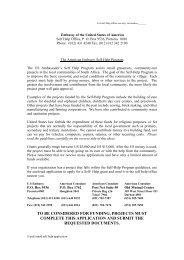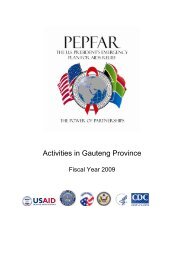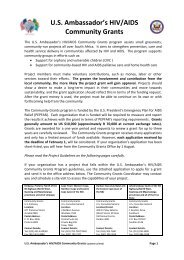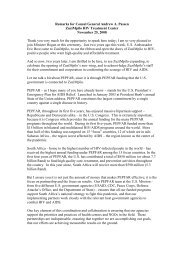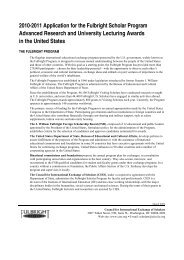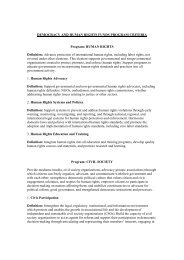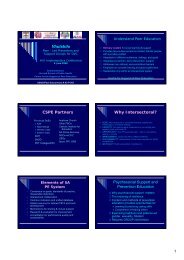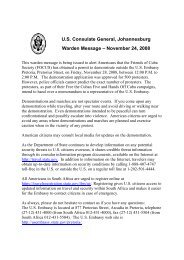Warning signs of physical abuse - South Africa
Warning signs of physical abuse - South Africa
Warning signs of physical abuse - South Africa
Create successful ePaper yourself
Turn your PDF publications into a flip-book with our unique Google optimized e-Paper software.
<strong>Warning</strong> <strong>signs</strong> <strong>of</strong> <strong>physical</strong> <strong>abuse</strong><br />
Physical child <strong>abuse</strong> usually takes place in the shadows <strong>of</strong> privacy. And<br />
because children are usually reluctant to report <strong>abuse</strong> by a parent or<br />
caregiver, it’s important to be on the lookout for warning <strong>signs</strong> that may<br />
indicate <strong>abuse</strong>. Your vigilance could save a child and get help for a family.<br />
Child <strong>abuse</strong> thrives in secrecy and privacy. It lives on inattention. The only<br />
way to stop or prevent it is by identifying the <strong>signs</strong> and reporting it to the<br />
authorities.<br />
But <strong>of</strong>ten it’s difficult to interpret <strong>signs</strong> <strong>of</strong> <strong>physical</strong> <strong>abuse</strong>, as these <strong>signs</strong><br />
may be confused with “normal” childhood injuries, such as bruises, and<br />
there are different standards that apply to the term.<br />
It’s important, therefore, to understand exactly what constitutes <strong>physical</strong><br />
<strong>abuse</strong> and what possible indicators are.<br />
What is child <strong>abuse</strong><br />
Physical <strong>abuse</strong> is any <strong>physical</strong> maltreatment or injury caused by the child’s<br />
parent or caregiver. It includes injuries sustained from burning, hitting,<br />
punching, kicking, shaking, choking, stabbing, drowning, poisoning, biting,<br />
scratching, and so on. Physical <strong>abuse</strong> usually occurs with other forms <strong>of</strong><br />
child <strong>abuse</strong>, such as emotional or sexual <strong>abuse</strong> and neglect.<br />
It isn’t necessary for the harm to be intentionally inflicted. More <strong>of</strong>ten than<br />
not, <strong>physical</strong> <strong>abuse</strong> is the unintentional end result <strong>of</strong> harsh disciplinary<br />
methods or corporal punishment that is inappropriate for the child’s age<br />
and that has escalated to point <strong>of</strong> <strong>physical</strong> injury or the risk <strong>of</strong> <strong>physical</strong><br />
injury. It may also be the result <strong>of</strong> recurrent lapses in the parent’s selfcontrol<br />
brought on by immaturity, stress, or the use <strong>of</strong> alcohol or illicit<br />
drugs.<br />
Research indicates that children requiring special care (such as premature<br />
babies or <strong>physical</strong>ly or mentally disabled children) or that are “difficult”<br />
to raise (such as children with Attention Deficit Hyperactivity Disorder<br />
or those with behavioural problems) are more susceptible to being<br />
maltreated than others.<br />
What are the <strong>signs</strong> <strong>of</strong> <strong>physical</strong> <strong>abuse</strong><br />
Of all the forms <strong>of</strong> child <strong>abuse</strong>, <strong>physical</strong> <strong>abuse</strong> is the most visible.<br />
However, because children <strong>of</strong>ten sustain bruises or abrasions while playing<br />
or being <strong>physical</strong>ly active, it’s difficult to distinguish these from <strong>abuse</strong><br />
indicators. Typically, these kinds <strong>of</strong> injuries would be on the leading or<br />
bony edges <strong>of</strong> the body, such as knees, elbows, forearms, or brows,<br />
and are rarely in distinct shapes, such as a hand, belt buckle, fingernail<br />
scratches that leave parallel linear marks, or adult teeth marks.<br />
Good indicators <strong>of</strong> <strong>physical</strong> <strong>abuse</strong> are bruises in s<strong>of</strong>t tissue areas, such as<br />
cheeks, buttocks, and thighs, as these are not usually injured during play<br />
or other <strong>physical</strong> activity. Other <strong>signs</strong> include:<br />
• Black eyes<br />
• Bruises and welts in various states <strong>of</strong> healing, in unusual patterns<br />
or clusters which would reflect the instrument or in multiple areas<br />
<strong>of</strong> the body<br />
• Missing, loose or broken teeth<br />
• Human bite marks<br />
• Burns that are in the shape <strong>of</strong> an iron, grill, or cigarette, or<br />
immersion burns that the child could not have inflicted upon<br />
himself<br />
• Bald spots on the head<br />
• Broken bones or fractures<br />
Unlike these, <strong>abuse</strong> directed at the abdomen or head, which are<br />
particularly vulnerable areas, usually go undetected, as many <strong>of</strong> the<br />
injuries are internal. Injuries to the abdomen can result in swelling,<br />
tenderness, and vomiting. Injuries to the head may cause swelling in the<br />
brain, dizziness, blackouts, retinal detachment, or even death. Referred to<br />
more recently as the “shaken baby” syndrome, violent shaking can cause<br />
severe damage in children at any age.
Children who are being <strong>physical</strong>ly <strong>abuse</strong>d may also show<br />
behavioural <strong>signs</strong>, depending on their age, developmental<br />
level, and level <strong>of</strong> functioning. Some <strong>of</strong> these include:<br />
• Changes in the child’s behaviour or school<br />
performance<br />
• Being aggressive, hyperactive, defiant or<br />
destructive<br />
• Being overly compliant with authority<br />
• Cowering or fear <strong>of</strong> adults<br />
• Frequent crying<br />
• Acting out, displaying aggressive or disruptive<br />
behaviour<br />
• Extreme shyness and social withdrawal or being<br />
uncommunicative<br />
• Moving or walking awkwardly<br />
• Coming to school too early or not wanting to leave<br />
school (indicating a possible fear <strong>of</strong> going home)<br />
• Fearlessness or extreme risk taking<br />
• Being described as “accident prone”<br />
• Cheating, stealing, or lying (note that this may be<br />
related to too high expectations at home)<br />
• Inability to form good peer relationships<br />
• Wearing clothing that covers the body and that<br />
may be inappropriate in warmer months (note that<br />
this may be a cultural issue as well)<br />
• Showing regressive or less mature behaviour<br />
• Disliking or shying away from <strong>physical</strong> contact with<br />
adults<br />
• Habitual absence from or lateness at school<br />
without explanation from parents<br />
• Substance <strong>abuse</strong><br />
• Risky sexual behaviours<br />
• Suicide attempts<br />
• Abnormal eating behaviours<br />
The possibility <strong>of</strong> <strong>physical</strong> <strong>abuse</strong> should also be considered if the parent or<br />
caregiver:<br />
• Offers conflicting, unconvincing, or no explanation for the child’s injury<br />
• Tries to conceal the child’s injuries<br />
• Overtly rejects the child<br />
• Describes the child as “evil,” or in some other very negative way<br />
• Uses harsh <strong>physical</strong> discipline with the child<br />
• Constantly blames, belittles, or berates the child<br />
• Seems unconcerned about the child<br />
• Abuses alcohol or other drugs<br />
• Has a history <strong>of</strong> <strong>abuse</strong> as a child<br />
Of course, the presence <strong>of</strong> a single sign does not prove child <strong>abuse</strong><br />
is occurring in a family. When these <strong>signs</strong> appear repeatedly or in<br />
combination, however, you should take a closer look at the situation<br />
and consider the possibility <strong>of</strong> child <strong>abuse</strong>. If you suspect that a child<br />
is being harmed, report the situation to the authorities immediately –<br />
before it’s too late.<br />
Copyright HealthInSite - www.healthinsite.net




